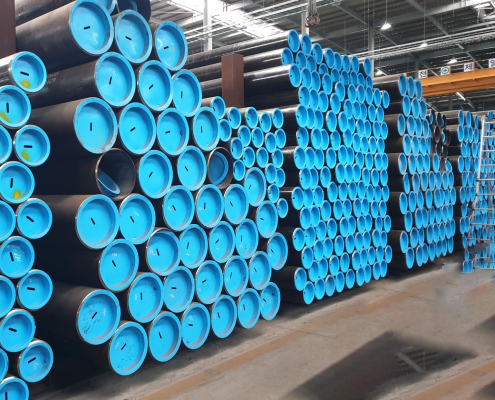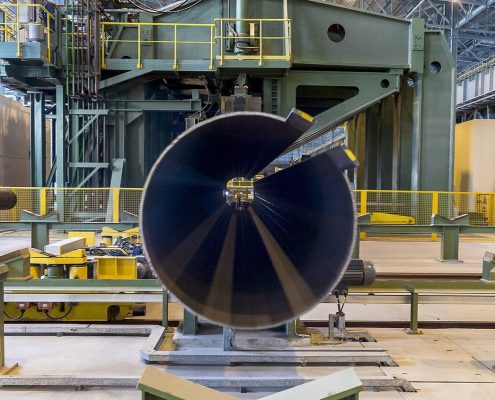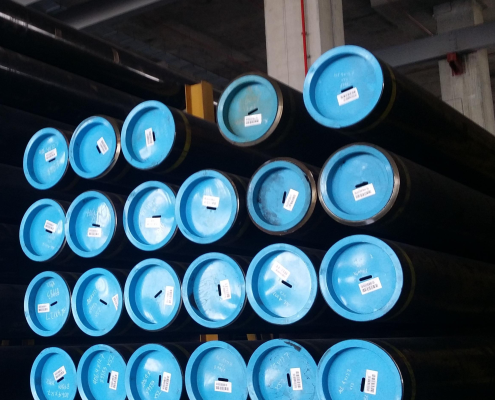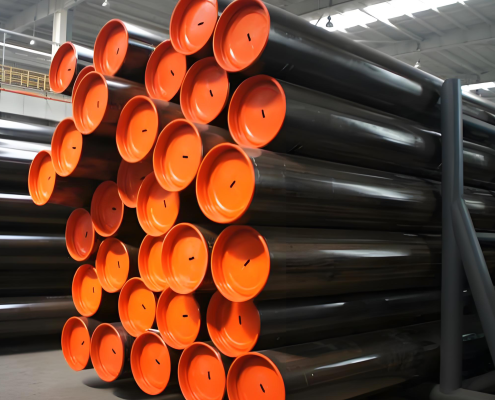Future Energy Steel offers high-quality Line Pipe with a wide range of grades and size options, including API 5L PSL 1 Line Pipe, API 5L PSL 2 line pipe, ASTM A335 alloy steel pipes for high-temperature service, ASTM A333 steel pipes for low-temperature service, ASTM A671 electric-fusion-welded steel pipes for atmospheric and lower temperatures, ASTM A672 electric-fusion-welded steel pipes for high-pressure service at moderate temperatures, and ASTM A691 carbon and alloy steel pipes for high-pressure service at high temperatures. These line pipes are ideal for various industrial applications, providing durability, reliability, and performance under different environmental conditions. Contact us at [email protected] for tailored solutions to meet your specific project needs.
FAQs
What is Line Pipe?
Line Pipe is a steel pipe used primarily for transporting oil, gas, water, and other fluids over long distances. It is designed to withstand high pressure and manufactured to meet specific standards to ensure safety, reliability, and efficiency in the transportation process. Line pipes are essential components in the infrastructure of the oil and gas industry and in water distribution systems.
What Are the Characteristics of Line Pipe?
Material Composition:
Typically made from carbon steel, although alloy steel and stainless steel options are available for specific applications requiring corrosion resistance or high strength.
Commonly used steel grades include X42, X52, X60, X70, and X80, which indicate the material’s yield strength.
Manufacturing Processes:
Seamless Line Pipe: Manufactured without a seam, it offers uniform strength and higher pressure resistance. It is suitable for high-pressure applications.
Welded Line Pipe: This category includes both Electric Resistance Welded (ERW) and Longitudinal Submerged Arc Welded (LSAW) pipes. Welded pipes are more economical and are used in a variety of applications.
Dimensional Specifications:
It is available in various sizes, from small diameters (less than 2 inches) to large diameters (up to 48 inches or more).
Wall thickness and length can be customized to meet specific project requirements.
Coatings and Linings:
Often coated with protective materials such as epoxy, polyethylene, or fusion-bonded epoxy (FBE) to enhance corrosion resistance.
Internal linings may also be applied to reduce friction and improve flow efficiency.
Standards and Certifications:
Manufactured according to standards such as API 5L (American Petroleum Institute), which specifies requirements for line pipes’ dimensions, materials, and mechanical properties.
Other standards include ISO 3183, an international standard for pipeline transportation systems, and ASTM standards for specific applications.
What Are the Applications of Line Pipe?
Line pipes are used in various sectors to transport fluids efficiently and safely. Some common applications include:
Oil and Gas Industry:
Crude Oil Transportation: Used to transport crude oil from production sites to refineries and storage facilities.
Natural Gas Pipelines: Essential for transporting natural gas from extraction points to processing plants and distribution networks.
Offshore Pipelines: Used in subsea environments to connect offshore oil and gas platforms to onshore facilities.
Water Distribution:
Municipal Water Supply: Used to distribute potable water from treatment plants to residential and commercial areas.
Irrigation Systems: Employed in agricultural applications to transport water for irrigation purposes.
Chemical and Petrochemical Industry:
Chemical Transport: Moving chemicals and petrochemical products between processing plants and distribution centers.
Energy Infrastructure:
Hydrogen Pipelines: Emerging applications include the transport of hydrogen gas in energy infrastructure.
What Are the Advantages of Line Pipe?
High Strength: Capable of withstanding high pressure and mechanical stresses.
Durability: Designed for long service life, even in harsh environments.
Versatility: Available in various sizes and materials to suit applications and requirements.
Efficiency: Enables the efficient transport of large volumes of fluids over long distances.
What Are the Differences Between API 5L SPL 1 and PSL 2 Line Pipes?
API 5L is a specification developed by the American Petroleum Institute (API) for line pipes used in oil, gas, and water transportation in the petroleum and natural gas industries. This specification has two product specification levels: PSL 1 and PSL 2. Each level defines different requirements for the production and testing of line pipes. Here are the critical differences between API 5L PSL 1 and PSL 2 line pipes:
1. Quality and Requirements
PSL 1 (Product Specification Level 1):
Basic quality level for line pipes.
Suitable for standard applications where more stringent specifications are not necessary.
Fewer chemical composition and mechanical property requirements.
Less stringent testing requirements compared to PSL 2.
PSL 2 (Product Specification Level 2):
Higher quality level with more rigorous requirements.
It is intended for more demanding applications where higher reliability is necessary.
Additional chemical composition controls and tighter mechanical property requirements.
More stringent testing, including non-destructive testing (NDT) for seam welds.
2. Chemical Composition
PSL 1:
Fewer restrictions on chemical composition.
Primary carbon steel grades with limited elements specified.
PSL 2:
More stringent control over chemical composition, including limiting elements like phosphorus and sulfur.
Specifies carbon equivalent (CE) limits to ensure better weldability and toughness.
It may include requirements for specific alloying elements for certain grades.
3. Mechanical Properties
PSL 1:
Basic tensile and yield strength requirements.
Notch toughness is generally not required.
PSL 2:
More demanding mechanical property requirements, including specific tensile and yield strength ranges.
Requires notch toughness testing, often through Charpy V-notch testing, to ensure fracture resistance at lower temperatures.
4. Testing and Inspection
PSL 1:
Limited testing requirements, primarily focused on hydrostatic testing and some dimensional checks.
Weld seam nondestructive testing (NDT) is not mandatory.
PSL 2:
Extensive testing requirements, including non-destructive testing of weld seams for welded pipes.
Requires more frequent mechanical testing, including tensile, hardness, and impact tests.
Additional testing for fracture toughness and hardness may be specified.
5. Traceability and Certification
PSL 1:
Basic traceability and certification requirements.
Documentation includes material test reports with basic mechanical properties and dimensions.
PSL 2:
Enhanced traceability and certification requirements.
Requires full material traceability and comprehensive documentation, including detailed material test reports and manufacturing records.
6. Applications
PSL 1:
Suitable for less critical applications where operating conditions are not extreme, and failure consequences are minimal.
Commonly used for the transportation of non-corrosive fluids and in standard operating conditions.
PSL 2:
Required for critical applications where higher reliability is necessary, such as in harsh environments or when transporting corrosive or hazardous materials.
It is often specified for offshore, deepwater, or sour service environments where failure could have significant safety or environmental impacts.
PSL 2 line pipes are subject to more stringent requirements and testing than PSL 1, making them suitable for more demanding applications with higher reliability and performance. The choice between PSL 1 and PSL 2 depends on the project’s specific requirements and the pipeline’s operating conditions.
What is the difference between offshore and onshore Line Pipes?
Offshore and onshore line pipes are essential components in the oil and gas industry, used to transport hydrocarbons from the production site to processing facilities or export terminals. However, they are designed to meet different environmental and operational challenges. Here are the key differences between offshore and onshore line pipes:
Offshore Line Pipes
Environment and Installation:
Location: Used in marine environments, such as oceans, seas, and sometimes large lakes, where oil and gas fields are underwater.
Installation: Due to underwater conditions, it requires specialized installation techniques, such as laying pipes on the seabed or burying them to protect against environmental factors.
Design Considerations:
Corrosion Resistance: Must have enhanced corrosion resistance to withstand the harsh marine environment, including exposure to saltwater and varying temperatures.
Pressure and Temperature: Designed to handle higher pressures and temperatures due to deepwater conditions and the need to transport fluids over long distances.
Structural Integrity: Requires greater structural integrity to withstand external pressures, underwater currents, and potential impacts from marine life or vessels.
Coatings and Materials: To ensure longevity, they are often coated with anti-corrosion materials and sometimes made from more exotic alloys or lined with corrosion-resistant materials.
Logistics and Maintenance:
Accessibility: More challenging to access for maintenance and repair, requiring specialized vessels and equipment.
Logistics: Installation and maintenance operations are more complex and costly due to the remote and underwater locations.
Onshore Line Pipes
Environment and Installation:
Location: Used on land, transporting oil and gas from wells to processing facilities, refineries, or export points.
Installation: Depending on the terrain and environmental considerations, it is typically installed using trenching, horizontal directional drilling, or surface laying.
Design Considerations:
Corrosion Resistance: Needs to resist corrosion from soil, moisture, and sometimes corrosive gases present in the transported fluids.
Pressure and Temperature: Generally designed for lower pressure and temperature compared to offshore pipes, although specific applications may vary.
Structural Integrity: Must be capable of withstanding soil movement, temperature fluctuations, and potential external impacts (e.g., from vehicles or machinery).
Logistics and Maintenance:
Accessibility: Easier access for inspection, maintenance, and repair than offshore pipes.
Logistics: Installation and maintenance operations are generally more straightforward and less expensive due to easier access and more straightforward logistics.
Key Differences
Environmental Conditions:
Offshore: Must withstand harsh marine environments, including saltwater corrosion, high external pressures, and temperature variations.
Onshore: Designed to handle soil conditions, temperature fluctuations, and potential exposure to air pollutants.
Installation and Logistics:
Offshore: Requires specialized equipment and vessels for installation and maintenance, with higher associated costs.
Onshore: Uses conventional construction techniques with more straightforward and less costly logistics and maintenance.
Material and Coating Requirements:
Offshore: Often requires more advanced materials and coatings for corrosion resistance and structural integrity.
Onshore: Typically uses standard steel grades with appropriate coatings for soil and atmospheric conditions.
Pressure and Temperature Handling:
Offshore: Designed for higher pressures and temperatures, especially in deepwater operations.
Onshore: Usually handles lower pressures and temperatures but varies based on specific applications.
Maintenance and Accessibility:
Offshore: More challenging and costly to access, inspect, and repair.
Onshore: Easier and more cost-effective to maintain and repair due to better accessibility.
What is Onshore Line Pipe?
An onshore line pipe is a pipeline used to transport oil, gas, or other fluids over land from production sites to processing facilities, refineries, storage terminals, or distribution centers. These pipelines are a crucial part of the oil and gas industry’s infrastructure and are designed to meet specific environmental and operational challenges encountered on land.
Key Characteristics of Onshore Line Pipes
Material and Construction:
Material: Typically made from carbon steel due to its strength, durability, and cost-effectiveness. However, other materials like stainless steel or composite materials may be used depending on the transported fluids and environmental conditions.
Construction: Line pipes are manufactured to meet specific standards, such as API 5L, which outlines requirements for different grades and types of steel pipes.
Design Considerations:
Pressure and Temperature: Designed to withstand the pressures and temperatures of the transported fluids, which vary depending on the specific application and location.
Corrosion Protection: Onshore line pipes are often coated with anti-corrosion materials, such as fusion-bonded epoxy (FBE) or polyethylene coatings, to protect against corrosion from soil, moisture, and other environmental factors.
Wall Thickness: The pipe’s wall thickness is determined based on the internal pressure, diameter, and strength requirements, ensuring it can handle operational stresses.
Installation Methods:
Trenching: The most common method involves digging a trench, laying the pipe, and backfilling the trench.
Horizontal Directional Drilling (HDD): Used for crossing obstacles such as roads, rivers, or other infrastructure without disturbing the surface.
Surface Laying: Pipelines may be laid on the surface in some cases, especially in remote or difficult-to-access areas, though this is less common.
Regulatory and Environmental Considerations:
Regulations: Onshore pipelines must comply with various local, state, and federal regulations that govern their construction, operation, and maintenance to ensure safety and environmental protection.
Environmental Impact: Environmental impact assessments are conducted during the planning and construction phases to minimize disruption to the surrounding ecosystem and reduce the risk of leaks or spills.
Maintenance and Monitoring:
Inspection: Regular inspections are conducted using techniques such as pigging (running inspection tools through the pipeline), visual inspections, and pressure testing to ensure integrity and detect any potential issues.
Monitoring: Pipelines are often equipped with sensors and monitoring systems to detect pressure, temperature, or flow rate changes that could indicate leaks or other problems.
Applications:
Crude Oil Transport: Used to move crude oil from production sites to refineries.
Natural Gas Transport: Moves natural gas from wellheads to processing plants and distribution networks.
Refined Product Transport: This involves transporting refined products, such as gasoline, diesel, or jet fuel, from refineries to storage facilities or distribution centers.
Advantages of Onshore Line Pipes
Efficiency: Provides a cost-effective and efficient way of transporting large hydrocarbon volumes over long distances.
Safety: Designed and operated with high safety standards to minimize the risk of leaks or accidents.
Reliability: Offers a reliable mode of transportation with relatively low maintenance requirements compared to other methods such as trucking or rail.
Overall, onshore line pipes are a vital component of the oil and gas industry. They provide a safe and efficient means of transporting energy resources to meet the demands of consumers and industries. Their design, installation, and operation are carefully managed to ensure safety, reliability, and environmental protection.
What is Offshore Line Pipe?
Offshore line pipes are specialized pipelines that transport oil, gas, or other fluids from offshore production facilities to onshore processing plants, storage facilities, or distribution networks. These pipelines play a critical role in the offshore oil and gas industry, enabling the extraction and transportation of resources from beneath the sea to land. Here are some key features and considerations associated with offshore line pipes:
Critical Characteristics of Offshore Line Pipes
Material and Construction:
Material: Typically made from high-strength carbon steel or alloy steel to withstand harsh marine environments and high pressures. Specialized materials such as stainless steel or composite materials may be used to resist corrosion.
Construction: Offshore line pipes are manufactured to meet stringent standards, such as API 5L or DNV-OS-F101, ensuring they can handle the challenging conditions of offshore environments.
Design Considerations:
Pressure and Temperature: Designed to withstand higher pressures and temperatures than onshore pipelines, particularly in deepwater or high-temperature reservoirs.
Corrosion Resistance: Enhanced corrosion resistance is crucial due to exposure to saltwater and marine conditions. Pipes are often coated with anti-corrosion materials and sometimes lined with corrosion-resistant alloys.
Structural Integrity: Must withstand external pressures from water depth, as well as dynamic forces such as currents, waves, and potential impacts from marine life or vessels.
Installation Methods:
Lay Barges: Specialized vessels are used to lay pipelines on the seabed. Pipes are welded on the vessel and then lowered into position.
S-Lay and J-Lay Methods: Techniques used for installing pipelines at different water depths. S-Lay is suitable for shallow to moderate depths, while J-Lay is used for deeper waters.
Trenching and Burial: In some cases, pipelines are buried beneath the seabed to provide additional protection against physical damage and environmental conditions.
Regulatory and Environmental Considerations:
Regulations: Must comply with international, national, and local regulations governing offshore installations to ensure safety and environmental protection.
Environmental Impact: Environmental impact assessments are conducted to minimize the impact on marine ecosystems and ensure responsible management of potential environmental risks.
Maintenance and Monitoring:
Inspection: Regular inspections using remotely operated vehicles (ROVs), divers, or pipeline inspection gauges (PIGs) ensure integrity and detect any potential issues.
Monitoring: Equipped with sensors and monitoring systems to detect pressure, temperature, or flow rate changes that could indicate leaks or other problems.
Applications:
Oil and Gas Transport: Connects offshore oil and gas fields to onshore facilities, enabling the extraction and transportation of hydrocarbons.
Export Pipelines: Transports processed oil or gas to export terminals or other countries.
Flowlines and Risers: Used within offshore fields to connect subsea wells to processing platforms.
Advantages of Offshore Line Pipes
Efficient Resource Transport: Provides a cost-effective and efficient way of transporting large hydrocarbons from offshore fields to onshore facilities.
Safety and Reliability: Designed and operated with high safety standards to minimize the risk of leaks or accidents in challenging marine environments.
Capability for Deepwater Operations: Engineered to handle the unique challenges of deepwater and ultra-deepwater operations, allowing access to previously untapped resources.








